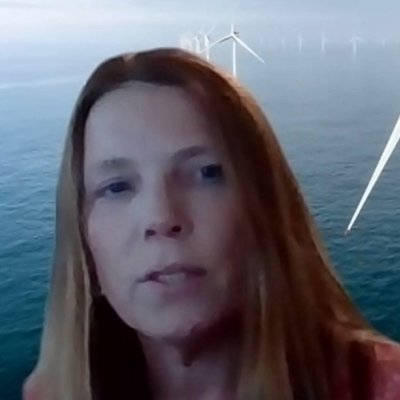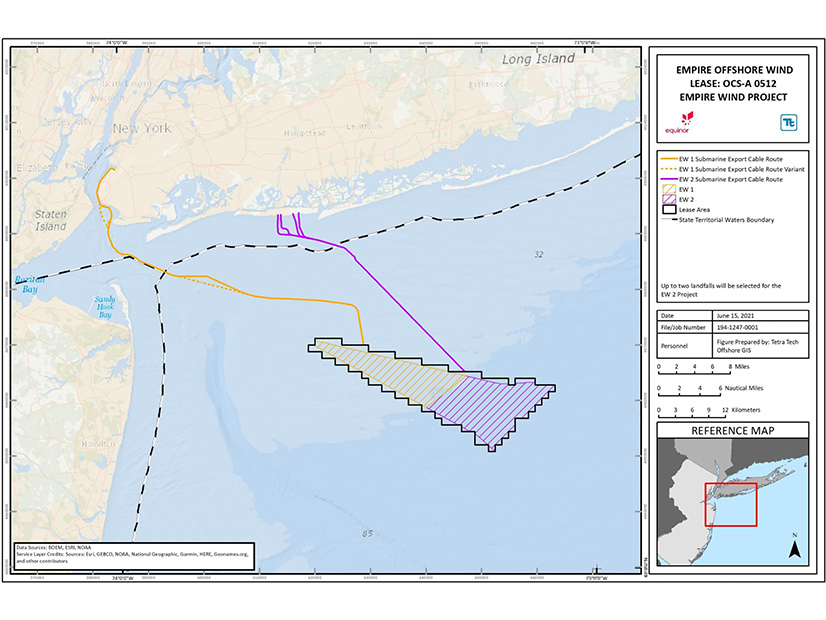Labor unions, environmentalists, state residents and energy professionals told federal officials Thursday they largely support the 2-GW Empire Wind project in the New York Bight. A clam fishery representative, however, accused the developer and state and federal governments of being insensitive to their special needs.
The Bureau of Ocean Energy Management (BOEM) on July 8 held the second of three public hearings, as the agency begins to review the project’s environmental impact with data from the developer’s construction and operations plan (COP). BOEM has scheduled the third hearing on July 13 at 1 p.m. for the project of Norwegian state-owned energy company Equinor Wind US.

“As we emerge from the COVID crisis … the economy, environmental justice and climate change are interwoven with offshore wind development,” said Mariah Dignan, the Long Island organizer for Climate Jobs New York (CJNY), a coalition of labor unions representing 2.6 million working New Yorkers. “We have a once-in-a-generation opportunity to put ourselves on the path to a low-carbon future, while creating new quality careers that provide family-sustaining wages and benefits for communities across the nation.”
Empire Wind consists of two separate projects, 810-MW Empire Wind 1 and 1,260-MW Empire Wind 2, awarded under different state solicitations and which will be electrically isolated and independent from each other, according to Laura Morales, Empire Wind’s environmental permit manager. The facilities will connect via offshore substations to separate points of interconnection onshore, she said.
BOEM will issue a draft environmental impact statement next summer and expects to issue a final decision of record in mid-2023, said Michelle Morin, chief of BOEM’s environmental branch for renewable energy. Comments for this round of review should be submitted no later than July 26.
Equinor plans to bring the Empire Wind project into service by 2025.
Clams and Piles
The clam industry would be negatively affected by installation of thousands of wind turbines in the mid-Atlantic and New England, said David Wallace, who spoke on behalf of the North Atlantic Clam Association.
The clam industry is unique in that it’s a directed fishery “that can only exist with being able to drive piles deep into the substrates and soft bottom without a lot of heavy rocks.”
OSW technology has developed since Equinor first acquired the lease in December 2016 for $42.5 million. The developer’s new COP proposes reducing the number of turbine foundations from 240 to 176, spacing turbines at least 0.7 nautical miles apart, and laying out the array in a Southwest-Northeast orientation that considers the dominant net fishing activities in the lease area, Morales said.
The Army Corps of Engineers insists on burying the export cables at least 15 feet below the seabed, she added.

Clammers have “proposed on numerous occasions to separate those turbines two nautical miles apart in straight lines, so that we could operate within those turbine arrays,” Wallace said “However, we have found that none of the developers are interested or willing to spread their turbines out … we are not interested in being collateral damage to very high rates of electric utilities.”
Stakeholders at a public hearing on the 800-MW Vineyard Wind project last July urged BOEM to approve the 1-nautical-mile turbine spacing advocated by developers and recommended by the U.S. Coast Guard, which the agency did earlier this year. (See Developers Seek 1-Mile Spacing for Vineyard Wind.)
The Empire Wind 1 export cable will make landfall in Brooklyn at the South Brooklyn Marine Terminal. After the energy is converted to AC, it will run through a cable underground to the point of interconnection, which is the Gowanus Substation, across second Avenue, Morales said.
For Empire Wind 2, the developer is looking at landfall alternatives to host two separate export cables to the point of interconnection at Oceanside, on the National Grid property in Island Park.
Tom Barracca, a career energy professional based in East Meadow, New York, said he was involved as a program manager in the 2002 Long Island Power Authority (LIPA) offshore wind study co-sponsored by the New York State Research and Development Authority.
“Although the offshore wind economics and technology wasn’t there 20 years ago, it is today, and Equinor and the Empire Wind team have done a tremendous job in planning these projects and making the necessary studies and due diligence,” Barracca said.
Supportive of the plan to deliver 2,000 MW of clean power into Consolidated Edison (NYSE: ED) territory, Barracca said the plans to feed into the LIPA load pocket in southwest Nassau County are especially useful for the region.
“As many people might know, there’s an aging power plant [the 610-MW E.F. Barrett Power Station] in Island Park that’s been upgraded many times and is still operating,” Barracca said. “National Grid is committed to make the best use of that, but quite frankly, it’s time for renewable power to be brought into Long Island and into New York City, and Empire’s plan to inject clean power into those load pockets is perfect timing.”
Urgent, Scenic Views
BOEM heard from members of the public about urgent action on climate change and the viewshed off New York’s coast.
“[A]fter yet another record-breaking and deadly month of heat waves, it seems to me that our absolute No. 1 priority for all energy projects should be simply, ‘Do they help us get to a carbon-neutral future?’” said Tara Noble, a lifelong New York resident.
If the answer is yes, she added, “we are obligated to pursue them without delay.”
The visual impact of the turbines is of deep concern to artist and Long Beach, N.Y., resident Michael Halpern.
Seeing wind turbines on the horizon would disturb him emotionally, aesthetically and spiritually, interfering with his visits to his late mother’s memorial bench on Riverside Boulevard, Halpern said.
The wind turbines, he said, would take “the magic of going to the beach away,” and when he paints, he added, “I’m not going to be looking out at eternity and God’s presence, I’m instead going to be looking at an industrial wasteland.”
While “not totally against clean energy,” Halpern said, he supports building solar panels and “wind turbines in specific places, but not here off the coast of Long Beach and New York City.”



